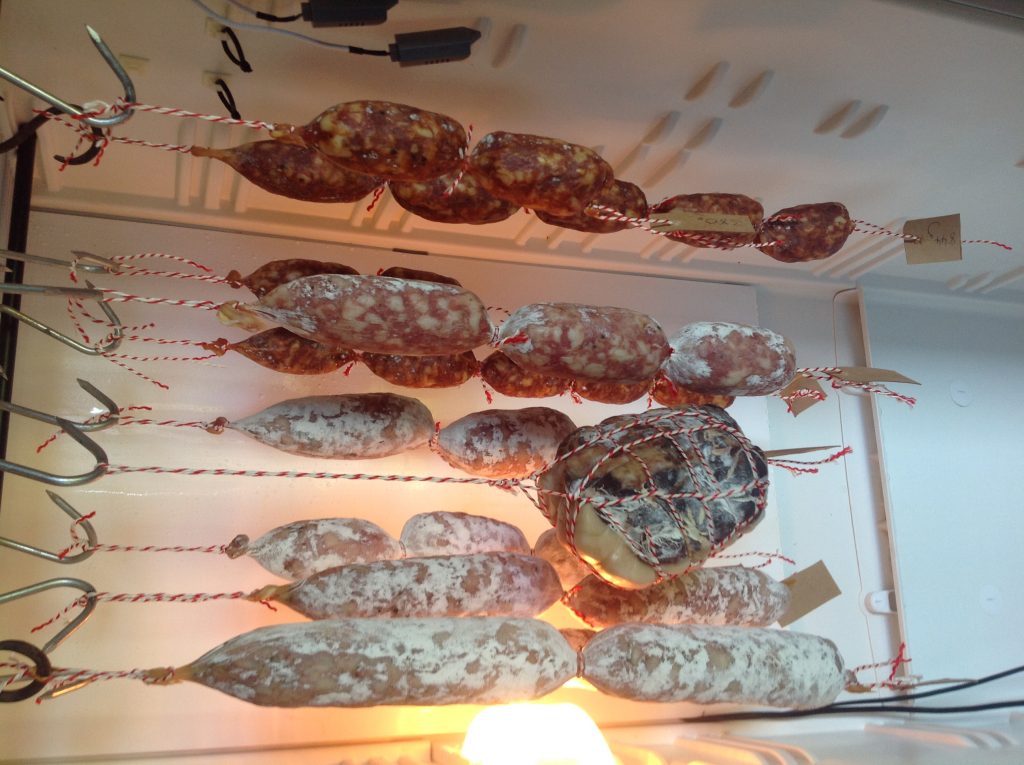This question seems to get asked quite a lot, especially among the less experienced rare breed pig keepers. It’s fairly easy to rear a couple of pigs but slaughter day inevitably comes and we often find ourselves without a clear idea as to how we’re going to cut them up. We might not be aware of all the options and all too often we just rely on the butchers advice.
They’re the expert right?
Well, yes they are but they are ‘generally’ experts in cutting traditional commercial joints from low fat commercial pigs and may rarely, if ever, come across ‘real pork’. They’ll happily (mostly or at least through gritted teeth) cut your carcass into roasting joints and chops, a few steaks, maybe cure you some bacon and convert the trim pile into a few dozen sausages. The trouble is they will leave that 2 inch layer of fat that you might not have been expecting on your joints and chops. The reason they do that is because you probably didn’t tell them not to. That’s not your fault (you may not have known it was there) or even the butchers fault (he’s just doing what’s asked of him/her) but it does result in less attractive joints and people won’t pay for a joint that’s 40% fat – Can’t say I blame them.

So, Yes! Maybe your pigs are too fat but only too fat for traditional cuts and joints.
That’s where you need to start thinking a bit more creatively.
If you find yourself disappointingly surprised by the amount of fat on your carcasses and your butcher just confirmed your suspicions you might think you have failed to produce the results that all that hard work and expense was supposed to be about. Maybe you were hoping to emulate the ‘commercial’ pork seen on supermarket shelves and had promised something like it but ‘better’ to your friends and family. If that’s the case I’m afraid you may have chosen the wrong breed and possibly the wrong customers. Slow grown, free range heritage and rare breeds are wonderfully designed to put down some beautifully flavoured fat and then as if by magic, you turn your back for 5 seconds and they put down some more. It is more than possible to consistently produce retail-able wonderful pork from rare breeds but it takes experience and knowledge and even then there will still be variations in fat from pig to pig.

I only grow a few pigs a year. They’re for my benefit and for friends and family to enjoy (although I am looking to release my Salami into the wild fairly soon). I’m not a commercial producer and as such I get big variations in the amount of fat my pigs put down. Sometimes they go off to slaughter a bit late and sometimes one is just greedier than the others. I’m not disappointed if my pigs come back a bit overweight…………It can only mean one thing.
Charcuterie!

You can only make top quality Salami, Pancetta, Guanciale and Chorica with top quality ingredients. Get your butcher to trim the excess fat off the joints and bag it up for you. You can always tie the skin back onto a joint for crackling. You’ll have attractive chops and joints with just the right amount of fat and a whacking great bag of white gold for the good stuff.
I definitely don’t see it as a failure if I get a pig back with 2 inches of back fat, wobbly great jowls and a belly that’s 70/30 fat to lean. I just butcher them slightly differently and make even more from the carcass. I’m not going to mince the jowls into a breakfast sausage, that’s for the rest of the trim. I’ll make Guanciale. It is simple to make and is delicious. Overly fat pieces of belly don’t lend themselves too well to traditional bacon or roasting so make Air Dried Pancetta. Salami in all its forms is a little more complicated but nonetheless achievable with a bit of research and some good fortune.
Pancetta Tesa, by the way, is probably the easiest to make of cured whole muscles. It requires little more than some salt, herbs and spices and a fridge and keeps almost indefinitely, improving with age.

Most of the world rejoices in the fat pig. The Chinese go mad for fat belly, the Italians make 100’s of different cured products that only work because of the fat. The Portuguese Porco Preto (Black Alentenjano Pig) is a monster of a pig and their amazing spicy Chorica are only as good as they are because of the fat. There’s a good reason Iberico Hams are so delicious and expensive. Pata Negra pigs will not win ‘Slimmer Of The Year’. There’s 1000’s of cured, dried, fermented, smoked, boiled, steamed and raw sausages in this world and they all need good quality fat to make them as good as they are.
Turning a heavyweight carcass into some fat chops and lardy roasting joints that need to be served with a side of Statins is one way of doing things but for me it’s definitely not the way forward. Fat pigs lend themselves to so much more than just the normal roasts, chops, a bit of bacon and pork n leek snags. We’ve got to have those things of course. They’re a traditional part of life in Great Britain and we love them but with some creative thinking and a bit of research you can get the best of both worlds from a fat pig.
Commercially attractive rare breed pork AND amazing Charcuterie.
I’m not sure there’s such a thing as too much fat, just a little more work to make the very best of it.